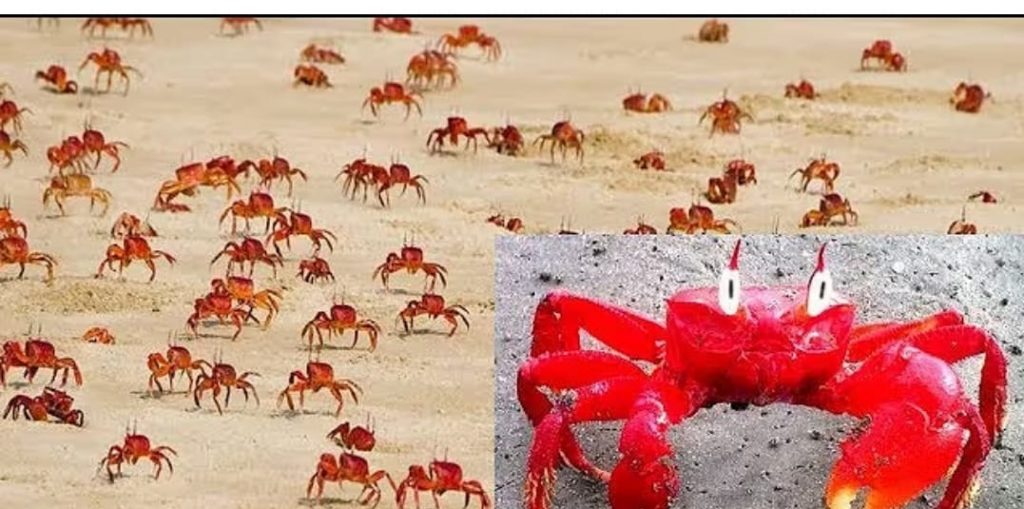Bhograi: Red ghost crab which plays an important role in preserving the ecological balance in the mangrove forests, maintaining biological diversity and protecting the marine environment have the unique ability to predict about natural calamities like cyclonic storms and Tsunamis in advance, a report said.
A rare marine creature, the red crab is seen on the lonely and still beaches of Talasari, Dagara, Chandipur and Balaramgadi on Balasore coast adjoining the saline forests while the beaches in Asia, Europe, Australia and America are the natural habitats of this marine creature. The Talasari beach draws scores of people who throng the beach to get a glimpse of the red ghost crabs that turn up in such huge numbers that the sand seems to turn red in colour.
Zoologists claim that these red crabs and horseshoe crabs, another rare type of crab have survived in this planet for the last several centuries. The blood of the horseshoe crab is used in preparation of medicines for critical diseases while the red crabs help protect the environment. Environmentalists and zoologists are of the view that more research needs to be done on this rare crab as they help in predicting natural calamities like cyclonic storms and Tsunamis. Their population has started declining while the species are facing extinction due to pollution, destruction of mangrove forests, rampant riding of bikes on the sea beach, deafening sound emanating from the trawlers, plastic and polythene pollution and poaching of the marine creatures.
Sources said over 1,000 million red crabs are seen on the deserted beaches of Odisha and West Bengal. The horseshoe crab and the red crab can be seen on Udayapur, Talasari, Bichitrapur, Dagara, Choumukh, Haskara, Dublagadi, Khandia river mouth as well as in Gahirmatha marine sanctuary of Bhitarkanika National Park in coastal Kendrapara district. They guard their burrows during the day and come out and move on the beach at night.
Similarly, these crabs are also seen in Digha, Shankarpur, Mandarmani, Sagar Island and in Sundarban of neighbouring West Bengal. They live in swampy mangrove forests and in the sand dunes of the sea beach by building a burrow of 20 to 25 inches. These crabs have two antennas on their upper part through which they can see their enemies from a distance and can hid themselves in the burrows. They survive on small marine creatures on the beach and the vegetation in the saline forest. The female crab lays eggs twice a year – November and March. The number of eggs they lay at a time is around 1,000 to 2,000. Some zoologists claim that the male or king crab can survive upto 20 to 30 years while some other claim they live upto four to six years.
Some small and big red crabs grow upto four to nine inch in length and seven to nine inch in height. These crabs play a crucial role in increasing the fertility of the soil and aid in growth of the mangrove forests and the vegetation in the area. They also help maintain the ecological diversity by inhaling carbon dioxide and releasing oxygen into the atmosphere. Saswat Kumar Jena, an environmentalist and zoologist, said that the red crabs are good sources of Omega-3 fatty acid, Vitamin B12 and they help in controlling unusual heartbeats in humans.
On the other hand, the horseshoe crabs are used to prepare medicines for chronic and serious illness among the humans and helps in controlling the global warming, eminent scientist Siddharth Pati said. Zoologist and Professor Bhaskar Behera demanded to conduct more research on the red ghost crabs through establishment of laboratories in various universities like the one for horseshoe crabs in Fakir Mohan University in Balasore.
Eminent artist and environmentalist Keshu Das said the protection of red ghost crabs is quite important for the conservation of marine creatures, their food and environment conservation for which the efforts to protect these crabs should continue. Abhijit Kumar Das, president of an environmental outfit Ananta Das Foundation, said various measures have been undertaken in relocation of red and horseshoe crabs.
Efforts are also being made to put an end to rampant bike riding on the sea beach, forest protection and free the beach of plastic, polythene and other wastes, he added. Bhograi MLA Goutam Buddha Das said he will raise the issue of safety of red and horseshoe crabs, and environmental degradation in the state Assembly.
PRADIP DAS, OP
